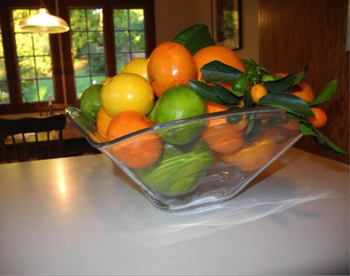Citrus
-
Scientific NameCitrus spp.
-
General InformationCitrus are evergreen shrubs or trees native to Asia and belong to the Rutaceae family. One of California’s most common backyard fruit trees.
 Photo: Anne-Marie Walker, Homegrown Varieties of Citrus
Photo: Anne-Marie Walker, Homegrown Varieties of Citrus -
When to Plant
Citrus can be planted any time of the year in frost-free zones. Otherwise, plant in spring.
-
Planting
Choose a warm sunny spot, that receives at least six hours of sun per day in February, with room for the tree at maturity: 20 feet high for standard varieties and up to 12 feet high for dwarf trees. Dig a hole twice as wide as the root ball and same depth as the root ball. After checking the bottom of the hole is firm, place citrus making sure the root ball and graft are about one-inch above the soil line. Citrus roots are shallow and will spread out to the canopy. Cover the roots with surrounding soil, water thoroughly, make a water basin and mulch three feet out from trunk holding the mulch three inches away from trunk. In cool summer areas, plant on south side of a dark wall to increase warmth and fruit quality. Dwarf varieties may be planted in containers.
-
Soil Requirements
Citrus prefer slightly acidic soil (pH 6.5-7) with good drainage.
-
Water Requirements
During the heat of summer, citrus requires at least four to six inches of water per month. Depending on soil type this many be divided into several applications, irrigating about once a week. On a hot day, a four year old semi-dwarf citrus may use 15 gallons of water while a mature, standard tree may use more than 50 gallons. Newly planted trees should be watered twice a week. Citrus like moist but not soggy soil. Monitor soil moisture as over watering can kill a citrus tree and it can also cause the fruit to split.
-
Fertilizing
Citrus benefit from regular feedings of high-nitrogen fertilizer. Recommended application times are January, May and June. Too much fertilizer produces excessive growth and invites problems with citrus leafminers and citrus disorders.
-
Pollination
Most citrus is self-fertile (does not need another tree nearby) and is pollinated by bees.
-
Harvesting
Citrus generally ripen in late fall through winter. Lemons and limes are considered ever-bearing but produce most in winter and spring. Ripening times vary; pick one for a taste test. Fruit left on the tree continues to sweeten. Once harvested, sugar production ceases. Harvest with clippers.
-
Storage
The best place to store citrus is on the tree. Once harvested, store citrus in the refrigerator for four to six weeks.
-
Good Varieties for Marin
Climate zones throughout Marin support lemons, limes and kumquats. Favorite varieties include ‘Improved Meyer Lemon’, ‘Eureka,’ ‘Bearss Lime’ and ‘Nagami Kumquat’. In Marin’s warmer inland zones, oranges and mandarins grow well. Favorite mandarins include ‘Satsuma’ and ‘Kishu’. Cuties and Sweeties sold in produce markets are mandarin orange hybrids. A favored orange is ‘Washington Navel’.
-
Helpful Tips
Although many citrus varieties like the ‘Washington Navel’ orange are seedless, they can get seeds if planted near ‘Improved Meyer Lemon.’ Increase distance between citrus varieties to maintain seedless fruit. Keep citrus growing area free of weeds. This also helps reduce crown rot infections.
Pruning: Citrus require little pruning for increased fruit bearing. They do benefit from aesthetic pruning and to let in more air and light to the center of the plant. Best pruning time is just before bloom or after spring fruit set. Prune off suckers and sports.
Learn more about pruning lemon trees.
-
Common Problems
Always keep the trunk of citrus dry to avoid rot diseases. Frost will damage both leaves and fruit of citrus. Frost temperature sensitivity is different for different varieties. As a rule of thumb, if temperatures are to drop to 30 degrees Fahrenheit or below, water tree and cover.
-
Pests- Diseases & More
Citrus can become infested with mites, scale, whiteflies, and thrips. Reduce the chance of infestation by periodically hosing off the leaves. Control of ants also helps ward off pests. Pick snails off citrus in the early morning. Watch for a new threat to California citrus; the Asian citrus psyllid. It’s a winged insect that carries a disease called citrus greening. There is no cure and citrus so infected are destroyed. For more information visit http://ipm.ucanr.edu/PMG/GARDEN/FRUIT/citrus.html

